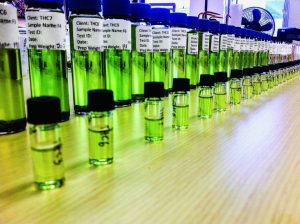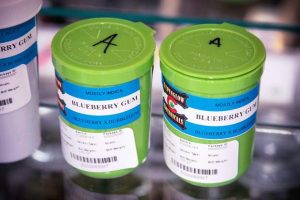On Monday, a marijuana-testing lab in Colorado presented data on 600 samples of legal recreational marijuana. The results show cause for concern: three times the potency that marijuana had in the 80s, a decrease in CBD levels—the ingredient attributed to medical marijuana success—and the presence of contaminants such as butane and fungus.
Marijuana has been under-rese arched, in great part due to the illegality of the drug. Most research has been stigmatized and the medical community has been heavily restricted in gaining access to research materials due to the Schedule I classification of the drug. The lack of scientific information we have on marijuana—and its effects or health consequences—is now becoming evident; the legalization of recreational marijuana in four US states (plus those that have legalized medical marijuana) has given way to the growing availability of a wide array of marijuana consumer products that are not properly regulated. Growing data, such as that presented on Monday at an American Chemical Society meeting shows that consumer protection is an area where legal marijuana regulation is still not up to par and where additional research and marijuana lab testing is strongly needed.
arched, in great part due to the illegality of the drug. Most research has been stigmatized and the medical community has been heavily restricted in gaining access to research materials due to the Schedule I classification of the drug. The lack of scientific information we have on marijuana—and its effects or health consequences—is now becoming evident; the legalization of recreational marijuana in four US states (plus those that have legalized medical marijuana) has given way to the growing availability of a wide array of marijuana consumer products that are not properly regulated. Growing data, such as that presented on Monday at an American Chemical Society meeting shows that consumer protection is an area where legal marijuana regulation is still not up to par and where additional research and marijuana lab testing is strongly needed.
CHARAS Scientific, the marijuana testing and research lab certified by the state of Colorado to perform mandatory potency testing for retail marijuana, is one of the labs that evaluates every marijuana product in the state. Because of this they have the ability to look at their data and analyses to look for trends. Over the last months, they analyzed the 600 samples of marijuana, both recreational and medical. Their findings brought up three important issues:
- Rising THC content
THC is the major psychoactive ingredient in marijuana, basically responsible for getting users “high”. What the samples have shown is that THC levels have risen markedly, to up to 30%. That is about three times stronger than marijuana in the 1980s. Andy LaFrate, researcher and study lead stated: “Potency used to be around 10% or less, but it’s been bred upwards over the years, presumably because the market has demanded it.” The same is true of legal weed in Washington; a spokesperson with the Washington State Liquor Control Board stated that some labs in Washington have seen THC levels as high as 40%.
Lewis Nelson, Professor and Vice Chair for Academic Affairs at NYU’s Department of Emergency Medicine and Director of Medical Toxicology Fellowship at the NYC Poison Control Center stated that rise in concentration of THC is not a concern per se, but that the variability does make it more difficult to pair the dose to the correct effect. He says that “users are more likely to consume excessive doses, leading to adverse clinical effects. This has been seen already in Colorado emergency departments.”
Nora Volkow, Director of the National Institute on Drug Abuse (NIDA) at the NIH, echoes these thoughts: “The higher the THC content, the stronger the effects on the brain (…) And the more likely you may end up with toxic reactions – like psychosis. Even the occasional user may end up in the ER. The very significant increase in ER visits – it’s due to THC content being much higher now. It’s not that we’ve increased the number of people taking marijuana.”
 Content labeling and dosing instruction
Content labeling and dosing instruction
To properly regulate this issue, mandatory testing needs to be done on the potency of the weed so that producers and sellers can label their products in a similar manner to printing alcohol content and levels of proof on a bottle label. Additionally, thresholds for the maximum THC content as well as dosages need to be determined as a precautionary measure until there is more research on the consequences of heavy or long-term use of marijuana on the brain.
- Declining levels of CBD
With the increase in levels of THC, the levels of cannabidiol, or CBD, have been declining. Data from CHARAS shows that most samples register low to non-existent levels of CBD. CBD is responsible for the therapeutic value of marijuana and is an ingredient that doesn’t get people high—a key trait for many people who are wary of buzz-inducing drugs and for potential medical treatments for children. Researchers have been interested in its use in treating schizophrenia, Huntington’s disease and Alzheimer’s, among other brain and mood disorders. It’s also been said to counter the antipsychotic effects of THC.
According to Mary Meek, the director of business development for CHARAS, THC and CBD counteract each other and “artisan growers have been focused on cross breeding for THC and they’ve been losing CBD”. This is problematic for medical marijuana users and medical research. It may mean that people who rely on CBD for medicinal properties aren’t getting much, if any, of it.
Regulating the medical marijuana markets
Currently, only Colorado and Washington regulate recreational marijuana testing. There is a need for other states that have legalized medical marijuana to follow suit. Minimum levels of CBD in medical marijuana should be determined to assure that medical marijuana growers are meeting certain CBD level requirements so that patient needs are met.
- The presence of contaminants
A third issue found in the samples is the presence of contaminants. Many marijuana products contain traces of butane, a chemical used to extract the potent THC from marijuana buds for edibles. Bacteria and fungus also grow on marijuana buds, which means that they’re in marijuana products. Meek and her colleagues have to think about how each product will be used. She says “There’s no data for what the consequences would be for smoking rather than consuming (…) The jury’s still out on how smoking E. coli might impact human health.”
Regulation of contaminants
Biological contaminants aren’t too surprising as marijuana is a plant. But there are no regulations on what’s safe and what’s not. What’s a safe threshold? Which contaminants do we need to be concerned about? The goal is to find an acceptable level for contaminants in marijuana products, just as the FDA requires manufacturers to test food and hygiene products for bacterial contamination.
What are Colorado and Washington doing about this?
Even though medical marijuana has been available in Washington since 1998, the state had never mandated testing until it approved recreational marijuana in 2013. Washington now has mandated testing with a detailed checklist of items to be analyzed, including: potency, contaminants, moisture and microbiology. Testing applies to marijuana flowers and buds as well as infused extracts for inhalation, infused edibles, liquids or topicals.
Colorado did not include mandatory testing in its initial regulations. One of the problems the state faced in the initial months after legalizing was the uncertainty of potency in marijuana edible products. This uncertainty led to two deaths and an increase in the number of visits to emergency rooms due to consumption of edibles. Starting in May 2014, makers of marijuana-infused cookies, cupcakes and candies were required to submit samples to newly licensed independent labs. If an individually packaged product exceeds the legal limit of 100 milligrams of THC, it is supposed to be blocked from reaching recreational store shelves. Mandatory potency testing for all recreational marijuana products, including flowers, concentrates and infused products (including edibles) is now required for recreational marijuana as of January 2015. Soon medical marijuana might have to meet those requirements as well. Consumers can find some parts of the results, such as potency, printed on packaging, while others can be requested.
Next steps
Legalization has not led to marijuana becoming a tested consumer product; marijuana testing is still very much a new phenomenon. At this stage, many growers don’t yet test their weed for potency, meaning that two buds might vary in their THC content—and its effects. In order to move forward, more research and research and regulation is key all around.
Legal marijuana will continue raising concerns. This is to be expected from a substance that has been legalized after almost 100 years of prohibition. Regulations will evolve as scientists, lawmakers and others learn more about the plant, its products and its public health effects. States that are considering legalization—or those that have already legalized medical marijuana—should take into account all the new available information when designing their regulatory models. The more we learn about legal marijuana in Colorado and Washington, the more we can prepare and mitigate health risks for upcoming changes in other states.



